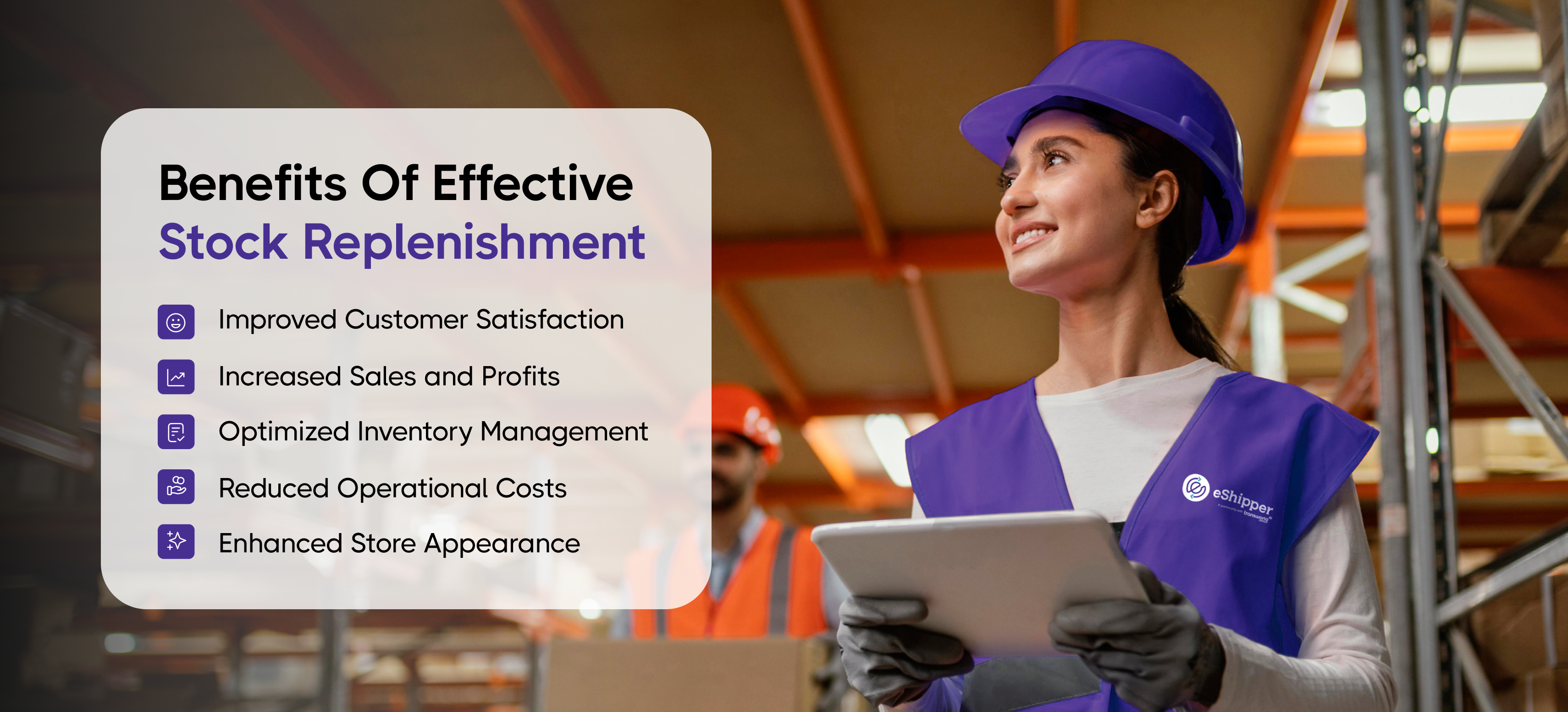Imagine walking into a retail store only to find that the item you desperately need is out of stock. Frustrating, isn’t it? Now, flip the scenario—imagine you’re the store owner, and this customer leaves empty-handed, possibly never to return.
Effective stock replenishment can make the difference between a satisfied, loyal customer and a missed sales opportunity. It’s also the backbone of effective retail inventory management, and ensuring that products are restocked promptly and efficiently is key to maintaining smooth operations and overall store profitability.
In this blog post, we'll explore how retail replenishment can enhance your store's efficiency and the strategies you can employ to optimize this process.
The Importance of Stock Replenishment in Retail
Retail replenishment is the process of restocking products that have been sold or removed from the inventory. This task is essential for keeping your store shelves full, meeting customer demand, and preventing stockouts. Your goal is to maintain a balance between having enough stock to meet demand and minimizing excess inventory that can tie up capital—and that’s what effective inventory replenishment is all about.
Benefits of Effective Stock Replenishment

- Improved Customer Satisfaction: One of the most significant benefits of efficient stock replenishment is enhanced customer satisfaction. When customers find the products they want in stock, they are more likely to make a purchase and return to your store in the future. For example, imagine a customer looking for a specific brand of baby formula. If they find it readily available every time they visit, they are more likely to trust your store and make it their go-to destination.
- Increased Sales and Profits: Avoiding stockouts means you won't miss out on potential sales. Having popular items readily available ensures that customers can always find what they need, leading to higher sales volumes and increased profits. Consider a scenario where an item, such as a best-selling holiday toy, is always in stock. This availability can significantly boost your sales during peak seasons.
- Optimized Inventory Management: Efficient retail store inventory management reduces the risk of overstocking or understocking. This balance is crucial for minimizing storage costs and maximizing the use of available space, and it also helps in reducing markdowns and losses resulting from unsold inventory. For instance, a fashion retailer can manage their inventory better by tracking which sizes and styles are selling quickly and replenishing those accordingly.
- Reduced Operational Costs: Streamlined inventory replenishment processes minimize the time and labor required to restock shelves. This efficiency lowers operational costs and allows staff to focus on other critical tasks, such as customer service and merchandising. An automated replenishment system can alert staff to restock specific items, reducing the need for manual checks and freeing up employees to assist customers.
- Enhanced Store Appearance: Regularly replenished shelves create a positive shopping environment that encourages customers to spend more time in your store, exploring different products and making additional purchases.
Strategies for Effective Retail Stock Replenishment
To reap the benefits of stock replenishment, consider implementing these retail stock replenishment strategies
- Automated Replenishment Systems: Utilize technology to automate the replenishment process. Automated systems can track sales data, predict demand patterns, and trigger orders when stock levels fall below a certain threshold. This reduces the risk of human error and ensures timely restocking.
- Just-in-Time (JIT) Inventory: Adopt a JIT inventory approach to minimize excess stock. This method involves ordering and receiving goods only when needed, reducing storage costs and the risk of holding obsolete inventory. For instance, an electronics store can order new gadgets based on sales forecasts to prevent overstocking outdated models.
- Vendor-Managed Inventory (VMI): Collaborate with suppliers through VMI programs. In this arrangement, suppliers take responsibility for monitoring and replenishing your stock levels, ensuring that you always have the right amount of inventory on hand. A supermarket, for instance, can partner with beverage suppliers to ensure popular drinks are always available without overstocking.
- ABC Analysis: Implement ABC analysis to categorize inventory based on its importance. Focus on regularly replenishing high-priority items (A-class) while managing lower-priority items (B and C-class) less frequently. This helps in prioritizing efforts and resources. For example, a pharmacy can prioritize replenishing prescription medications over less critical items like accessories.
- Safety Stock Levels: Maintain safety stock levels to buffer against unexpected demand spikes or supply chain disruptions. Safety stock acts as a cushion, preventing stockouts during peak periods or unforeseen delays. For instance, a hardware store can keep extra stock of essential supplies during the UAE’s rainfall season to meet sudden increases in demand should flooding occur.
Stock Replenishment Services
Outsourcing stock replenishment services can be a viable option for retailers looking to optimize their inventory management. These services offer specialized expertise, technology, and resources to handle replenishment tasks efficiently. By leveraging professional services, retailers can focus on core business activities while ensuring that their inventory is well-managed.
Out-of-Stock Prevention and Inventory Restocking Methods
Preventing stockouts is critical for maintaining customer satisfaction and sales. Here are some inventory restocking methods to consider:
- Regular Stock Audits: Conduct regular audits to assess stock levels and identify discrepancies. This helps in maintaining accurate inventory records and preventing stockouts. For example, a clothing store can conduct weekly audits to ensure that popular sizes and styles are always available.
- Demand Forecasting: Use historical sales data and market trends to forecast future demand. Accurate demand forecasting allows you to plan replenishment activities more effectively. A toy store, for instance, can use past holiday sales data to predict and prepare for seasonal spikes.
- Continuous Monitoring: Implement continuous monitoring systems to track inventory levels in real-time. This enables prompt action when stock levels are low, preventing stockouts. A beauty supply store can use real-time monitoring to ensure that high-demand products like skincare items are always in stock.
- Collaborative Planning: Work closely with suppliers and stakeholders to align replenishment schedules with sales patterns and promotional activities. Collaborative planning ensures that inventory is replenished in sync with demand. For example, a supermarket can coordinate with its suppliers to restock popular items during a major sale event.
Final Thoughts
Efficient retail replenishment is vital for enhancing your store's efficiency and overall success. By adopting the right strategies and leveraging technology, you can ensure that your shelves are always stocked, customers are satisfied, and operational costs are minimized. Whether you choose to automate your processes, collaborate with suppliers, or outsource services, effective stock replenishment will undoubtedly improve your retail store's efficiency and profitability.
eShipper’s inventory management services are designed to streamline your logistics operations and maximize efficiency. We utilize cutting-edge technology to provide real-time tracking, precise inventory control, and seamless integration with your supply chain.
Whether you're a small business or a large enterprise, our tailored solutions ensure optimal stock levels, minimize storage costs, and prevent stockouts. Contact us to explore how we can help you keep your inventory optimized and your business running smoothly.






